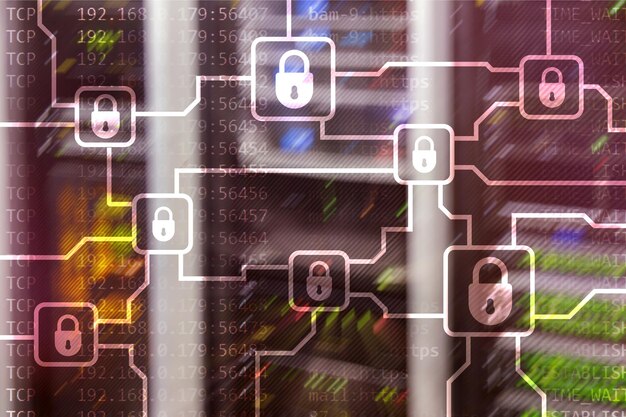Emergency Alert: Safeguard Your Gov Benefits from Cyber Threats

Emergency Alert: New Cybersecurity Threats Targeting Government Benefits – Protect Yourself Now warns of escalating cyber risks targeting government benefits, emphasizing the need for immediate protective measures to safeguard personal data and financial resources.
Are you aware of the latest cybersecurity threats targeting your government benefits? An Emergency Alert: New Cybersecurity Threats Targeting Government Benefits – Protect Yourself Now is in effect, and understanding the risks is the first step in protecting yourself.
Understanding the Escalating Cybersecurity Threat Landscape
The digital age has brought unprecedented convenience to accessing government benefits, but it has also opened doors for cybercriminals. Understanding the current threat landscape is crucial for anyone receiving these benefits.
Cybersecurity threats are becoming increasingly sophisticated, with criminals constantly evolving their tactics to exploit vulnerabilities in online systems. This section delves into these threats, highlighting the importance of staying vigilant and informed.
Common Types of Cyberattacks Targeting Government Benefits
Several types of cyberattacks frequently target government benefit systems. Recognizing these threats is key to prevention.
- Phishing: Cybercriminals use deceptive emails, messages, or websites to trick individuals into revealing sensitive information, such as usernames, passwords, or social security numbers.
- Malware: Malicious software, including viruses, worms, and ransomware, can infect devices and compromise data used to access government benefits.
- Identity Theft: Criminals steal personal information to impersonate individuals and fraudulently claim benefits or access accounts.

Why Government Benefits Are a Prime Target for Cybercriminals
Government benefit systems are a particularly attractive target for cybercriminals due to the high volume of personal and financial data they contain.
- Valuable Data: These systems hold a wealth of sensitive information, including social security numbers, bank account details, and addresses, making them a goldmine for identity theft and financial fraud.
- Scale of Impact: Successful attacks can impact thousands or even millions of individuals, resulting in significant financial losses and disruption of services.
- Vulnerabilities: Some systems may have outdated security measures or unpatched vulnerabilities, making them easier to exploit.
In summary, the rise in sophisticated cyberattacks necessitates increased awareness and proactive measures to protect government benefits. Staying informed and adopting robust cybersecurity practices are essential in mitigating these risks.
Recognizing Phishing Scams and How to Avoid Them
Phishing scams are a prevalent method used by cybercriminals to steal sensitive information. Understanding how to identify and avoid these scams is crucial for protecting your government benefits.
Phishing attempts often masquerade as legitimate communications from government agencies or financial institutions. This section provides guidance on recognizing these deceptive tactics and safeguarding your personal information.
Key Indicators of a Phishing Scam
Several red flags can help you identify a potential phishing scam.
- Unsolicited Requests for Information: Be wary of emails or messages that ask for personal information, especially if you did not initiate the communication.
- Suspicious Links or Attachments: Avoid clicking on links or opening attachments from unknown or untrusted sources, as they may contain malware or lead to fake websites.
- Poor Grammar and Spelling: Phishing emails often contain grammatical errors, typos, and awkward phrasing, which can be indicators of their illegitimacy.
Best Practices for Avoiding Phishing Scams
Adopting these best practices can significantly reduce your risk of falling victim to phishing scams.
- Verify Sender Identity: Always check the sender’s email address and verify its authenticity by contacting the organization directly through official channels.
- Enable Two-factor Authentication: Use two-factor authentication (2FA) whenever possible to add an extra layer of security to your accounts.
- Keep Software Updated: Regularly update your operating system, antivirus software, and web browser to patch security vulnerabilities.

By staying vigilant and practicing these precautions, you can significantly reduce your vulnerability to phishing scams and protect your government benefits from cyber threats. Remember, cautious behavior is your best defense.
Securing Your Online Accounts with Strong Passwords and Two-Factor Authentication
The security of your online accounts is paramount in protecting your government benefits from cyber threats. Implementing strong passwords and enabling two-factor authentication (2FA) are essential steps.
Weak passwords and the absence of 2FA make your accounts vulnerable to unauthorized access. This section outlines the importance of these security measures and provides practical tips for implementation.
Creating Strong, Unique Passwords
A strong password is the first line of defense against cyberattacks.
- Password Length: Aim for passwords that are at least 12 characters long.
- Complexity: Include a mix of uppercase and lowercase letters, numbers, and symbols.
- Avoid Common Words: Do not use dictionary words, names, or easily guessable phrases.
Enabling and Using Two-Factor Authentication (2FA)
Two-factor authentication adds an extra layer of security by requiring a second verification method in addition to your password.
- How 2FA Works: Typically, 2FA involves receiving a code via SMS, email, or an authenticator app to confirm your identity.
- Benefits of 2FA: Even if your password is compromised, 2FA prevents unauthorized access to your account without the second verification factor.
- Implementing 2FA: Enable 2FA on all accounts that offer it, especially for government benefit portals and financial institutions.
In conclusion, utilizing strong, unique passwords and enabling two-factor authentication are critical steps in securing your online accounts and protecting your government benefits from unauthorized access. These measures significantly enhance your overall cybersecurity posture.
Monitoring Your Credit Report and Financial Statements for Suspicious Activity
Regularly monitoring your credit report and financial statements is an essential practice for detecting and addressing suspicious activity that could jeopardize your government benefits.
Cybercriminals often target financial information to commit fraud and identity theft. This section emphasizes the importance of proactive monitoring and provides guidance on how to do so effectively.
How to Access and Review Your Credit Report
Your credit report contains valuable information about your credit history and can help you identify potential fraud.
- AnnualCreditReport.com: You are entitled to a free credit report from each of the three major credit bureaus (Equifax, Experian, and TransUnion) annually.
- Review for Discrepancies: Look for unfamiliar accounts, addresses, or inquiries that you did not authorize.
- Report Errors: If you find any errors, report them to the credit bureau immediately to have them corrected.
Examining Your Financial Statements for Fraudulent Transactions
Regularly reviewing your bank and benefit statements can help you detect unauthorized transactions.
- Check for Unfamiliar Charges: Look for any charges or withdrawals that you do not recognize.
- Monitor Benefit Payments: Ensure that your benefit payments are being deposited correctly and on time.
- Report Suspicious Activity: If you notice any suspicious activity, contact your bank or benefit provider immediately.
In summary, consistent monitoring of your credit report and financial statements is crucial for safeguarding your government benefits from fraud and identity theft. By detecting and reporting suspicious activity promptly, you can minimize potential damages.
Reporting Cybersecurity Incidents and Seeking Assistance
Knowing how to report cybersecurity incidents and where to seek assistance is crucial in mitigating the impact of a cyberattack on your government benefits.
Prompt reporting and access to support can help you recover from a cyberattack and prevent further damage. This section provides essential information on reporting procedures and available resources.
Who to Contact When You Suspect a Cybersecurity Incident
Depending on the nature of the incident, several agencies and organizations can provide assistance.
- Benefit Provider: Contact your government benefit provider immediately if you suspect your account has been compromised.
- Federal Trade Commission (FTC): Report identity theft and fraud to the FTC at IdentityTheft.gov.
- Internet Crime Complaint Center (IC3): File a complaint with the IC3 for internet-related crimes, such as phishing and malware attacks.
Steps to Take After Reporting a Cybersecurity Incident
After reporting a cybersecurity incident, take these steps to protect yourself further.
- Change Passwords: Update your passwords for all affected accounts, using strong and unique passwords.
- Monitor Accounts: Continue to monitor your credit report and financial statements for any signs of fraud.
- Consider a Credit Freeze: Place a credit freeze on your credit reports to prevent new accounts from being opened in your name.
In conclusion, knowing who to contact and what steps to take after a cybersecurity incident is essential for protecting your government benefits and mitigating potential damages. Prompt reporting and proactive measures can help you recover and prevent further harm.
Staying Updated on the Latest Cybersecurity Threats and Best Practices
The cybersecurity landscape is constantly evolving, making it essential to stay informed about the latest threats and best practices to protect your government benefits.
Continuous learning and awareness are key to maintaining a strong cybersecurity posture. This section provides resources and tips for staying updated on emerging threats and effective security measures.
Reliable Sources for Cybersecurity News and Updates
Staying informed requires consulting reputable sources for cybersecurity information.
- Government Agencies: The FTC, Cybersecurity and Infrastructure Security Agency (CISA), and other government agencies provide valuable resources and alerts.
- Cybersecurity Blogs and Websites: Follow reputable cybersecurity blogs and websites for the latest news, analysis, and tips.
- Security Software Vendors: Security software vendors often publish reports and updates on emerging threats and vulnerabilities.
Implementing a Continuous Learning Approach
Make cybersecurity awareness a regular part of your routine.
- Subscribe to Newsletters: Sign up for newsletters from trusted cybersecurity sources to receive updates directly in your inbox.
- Attend Webinars and Conferences: Participate in webinars and conferences to learn about the latest trends and best practices.
- Share Information: Share your knowledge with friends and family to help them protect themselves from cyber threats.
In summary, staying updated on the latest cybersecurity threats and best practices is crucial for maintaining a strong defense against cyberattacks targeting your government benefits. Continuous learning and awareness are key to protecting yourself in the ever-evolving digital landscape.
| Key Aspect | Brief Description |
|---|---|
| 🚨 Recognize Threats | Be aware of phishing, malware, and identity theft targeting benefits. |
| 🛡️ Secure Accounts | Use strong passwords and enable two-factor authentication for all accounts. |
| 🔎 Monitor Regularly | Check credit reports and financial statements for suspicious activity. |
| 📞 Report Incidents | Contact benefit providers and report fraud to agencies like the FTC. |
Frequently Asked Questions (FAQ)
▼
Benefits like Social Security, unemployment, and Medicare are often targeted due to their broad reach and sensitive personal data.
▼
Legitimate requests rarely ask for sensitive data via email. Verify by contacting the agency directly through official channels.
▼
Immediately change your password, notify the benefit provider, and monitor your accounts for any suspicious activity.
▼
Accessing sensitive accounts on public Wi-Fi is risky. Use a secure, private network or a VPN for added security.
▼
Report incidents to the Federal Trade Commission and the Internet Crime Complaint Center for internet-related crimes.
Conclusion
Protecting your government benefits from cybersecurity threats requires vigilance, awareness, and proactive measures. By understanding the risks, implementing strong security practices, and staying informed, you can safeguard your personal information and financial resources in the digital age.






